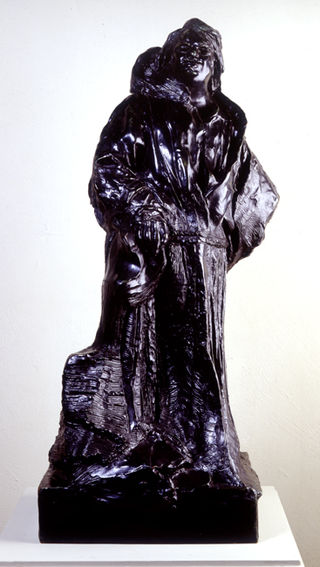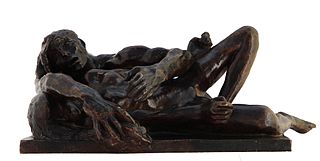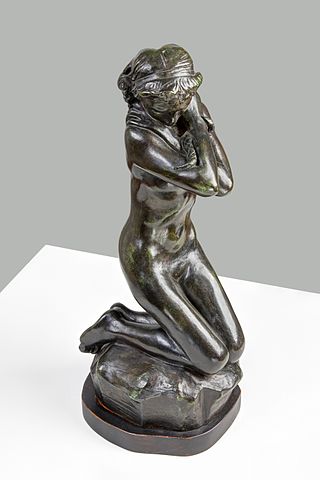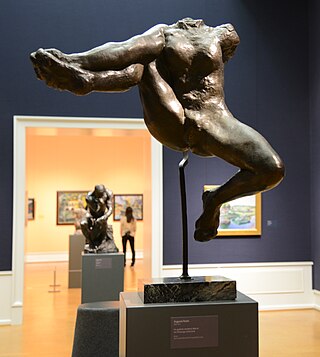
François Auguste René Rodin was a French sculptor generally considered the founder of modern sculpture. He was schooled traditionally and took a craftsman-like approach to his work. Rodin possessed a unique ability to model a complex, turbulent, and deeply pocketed surface in clay. He is known for such sculptures as The Thinker, Monument to Balzac, The Kiss, The Burghers of Calais, and The Gates of Hell.

The Thinker is a bronze sculpture by Auguste Rodin, usually placed on a stone pedestal. The work depicts a nude male figure of heroic size sitting on a rock. He is seen leaning over, his right elbow placed on his left thigh, holding the weight of his chin on the back of his right hand. The pose is one of deep thought and contemplation, and the statue is often used as an image to represent philosophy.

The Burghers of Calais is a sculpture by Auguste Rodin in twelve original castings and numerous copies. It commemorates an event during the Hundred Years' War, when Calais, a French port on the English Channel, surrendered to the English after an eleven-month siege. The city commissioned Rodin to create the sculpture in 1884 and the work was completed in 1889.

The Musée Rodin of Paris, France, is an art museum that was opened in 1919, primarily dedicated to the works of the French sculptor Auguste Rodin. It has two sites: the Hôtel Biron and surrounding grounds in central Paris, as well as just outside Paris at Rodin's old home, the Villa des Brillants at Meudon, Hauts-de-Seine. The collection includes 6,600 sculptures, 8,000 drawings, 8,000 old photographs and 7,000 objets d'art. The museum receives 700,000 visitors annually.

The Gates of Hell is a monumental bronze sculptural group work by French artist Auguste Rodin that depicts a scene from the Inferno, the first section of Dante Alighieri's Divine Comedy. It stands at 6 metres high, 4 metres wide and 1 metre deep (19.7×13.1×3.3 ft) and contains 180 figures.

The Age of Bronze is a bronze statue by the French sculptor Auguste Rodin (1840–1917). The figure is of a life-size nude male, 72 in. (182.9 cm) high. Rodin continued to produce casts of the statue for several decades after it was modelled in 1876.

The Walking Man is a bronze sculpture by the French sculptor Auguste Rodin. This sculpture was made in 1907.

Monument to Balzac is a sculpture by Auguste Rodin in memory of the French novelist Honoré de Balzac. According to Rodin, the sculpture aims to portray the writer's persona rather than a physical likeness. The work was commissioned in 1891 by the Société des Gens de Lettres, a full-size plaster model was displayed in 1898 at a Salon in Champ de Mars. After coming under criticism the model was rejected by the société and Rodin moved it to his home in Meudon. On 2 July 1939 the model was cast in bronze for the first time and placed on the Boulevard du Montparnasse at the intersection with Boulevard Raspail.

Saint John the Baptist (preaching) is a bronze sculpture, by Auguste Rodin.

Cybele is a sculpture by French artist Auguste Rodin. It is one of the first of Rodin's partial figures known as "fragments" to be displayed as sculpture in its own right, rather than an incomplete study.

Balzac in the Robe of a Dominican Monk is a bronze sculpture by French artist Auguste Rodin, one of the studies made in preparation to the Monument to Balzac, a tribute to novelist Honoré de Balzac commissioned by the Society of Men of Letters of France in 1891.

The Falling Man is a sculpture by French artist Auguste Rodin modeled in 1882 and is part of Rodin's emblematic group The Gates of Hell.

I Am Beautiful, also known as The Abduction, is a sculpture of 1882 by the French artist Auguste Rodin, inspired in a fragment from Charles Baudelaire's collection of poems Les Fleurs du mal.

Avarice and Lust is a sculpture by French artist Auguste Rodin, conceived between 1885 and 1887, representing two of the seven capital sins and is part of his sculptural group The Gates of Hell, where it can be found in the lower part of the right door. It's possible that the name was inspired by Victor Hugo's poem Après une lecture du Dante:

Eve is a nude sculpture by the French artist Auguste Rodin. It shows Eve despairing after the Fall.

The Three Shades is a sculptural group produced in plaster by Auguste Rodin in 1886 for his The Gates of Hell. He made several individual studies for the Shades before finally deciding to put them together as three identical figures gathered around a central point. The heads hang low so that the neck and shoulders form an almost-horizontal plane. They were to be placed above the gates looking down on the viewer.

Despair or Despair at the Gate is a sculpture by Auguste Rodin that he conceived and developed from the early 1880s to c. 1890 as part of his The Gates of Hell project. The figure belongs to a company of damned souls found in the nine circles of Hell described by Dante in The Divine Comedy. Other title variations are Shade Holding her Foot, Woman Holding Her Foot, and Desperation. There are numerous versions of this work executed as both plaster and bronze casts and carved marble and limestone.

Young Woman with a Serpent is a c. 1885 sculpture by Auguste Rodin, realised in several media. The artist later used the figure in his 1905 Adam and Eve.

Adam is an 1880-1881 statue of Adam by Auguste Rodin, first exhibited at the Paris Salon that year entitled The Creation of Man.

Iris, Messenger of the Gods is a bronze sculpture by Auguste Rodin. A plaster model, created between 1891 and 1894, was cast in bronze by Fonderie Rudier at various times from about 1895. Iris is depicted with her right hand clasping her right foot and her naked body posed provocatively with her legs spread wide, displaying her genitalia.




















